In the past month, “My Hero Academia” has celebrated the 3rd anniversary of its’ serialisation in “Weekly Shōnen Jump.” However, at a time when both “One Piece” and “Weekly Shōnen Jump” itself are also celebrating anniversaries far exceeding that of MHA’s three years (20 and 49 years respectively), this may seem like a trivial milestone. Yet for a mangaka like Kōhei Horikoshi — whose two previous works in “Weekly Shōnen Jump” (“Oumagadoki Zoo” and “Barrage”) never even reached a year of serialisation — this is undoubtedly an amazing feat that will fill him with pride. And rightly so.

After looking over the celebratory colour spread accompanying this achievement, a few things have become increasingly clear to me regarding Horikoshi’s work on “My Hero Academia.” The first, is he has managed to craft an incredibly diverse and dynamic roster of characters over a relatively short amount of time, especially when compared to other flagship series for “Weekly Shōnen Jump.” The other is just how vast and memorable (in design and demeanour) the cast is.
After all, the colour spread only depicts characters with an affiliation to members of the titular ‘Hero Academia’ of U.A. High. Beyond that are: members of other hero institutions (like Ketsubutsu and Shiketsu), Pro Heroes (both ranking ones, such as Edge Shot and Gang Orca, and hero teams, like the Pussycats), solo villains (Stain), villainous groups (e.g. the League of Villains and the Shie Hassaikai), the Police Force (like Naomasa Tsukauchi), and civilians (including the families related to the members of Class 1-A). Horikoshi skillfully establishes and develops interesting characters. His ability to balance an array of faceted characters only serves to further enhance my excitement in see what else will be explored in the upcoming months and years of “My Hero Academia.”
The content of this past month’s chapters (numbered 144 through 148) provides plenty to discuss. The first is from the groundwork Horikoshi laid in the first few years of serialisation. He is now capable of taking the story (and its inhabitants) in a number of interesting directions. While at first the narrative may have adhered strictly to the journey of the primary protagonist, Horikoshi is now willing to delve deeper into the history and mentality of a number of characters that may have previously been categorised as the supporting cast. To emphasise this, the current arc has included flashbacks for the heroes Tamaki “Suneater” Amajiki (and by extension, Mirio “Lemillion” Togata) and Eijirou “Red Riot” Kirishima (featuring Mina “Pinky” Ashido).
Previous flashbacks with characters like Ochaco Uraraka, Tenya Iida and Shoto Todoroki were interspersed with events in the present. The recent look back at Red Riot’s time in middle school, however, had far more time dedicated to it (to the extent that chapters 144 and 145 were titled ‘Red Riot (1)’ and ‘Red Riot (2)’ and almost all of the two chapters were spent away from the present day). While this particular flashback is different from the others in this series so far, it also stands out as different from the flashbacks found in the majority of other shōnen series. This is due to its placement: within the fight between Fat Gum and Red Riot, and two of the Hassai group’s Eight Bullets – Rappa and Tengai.
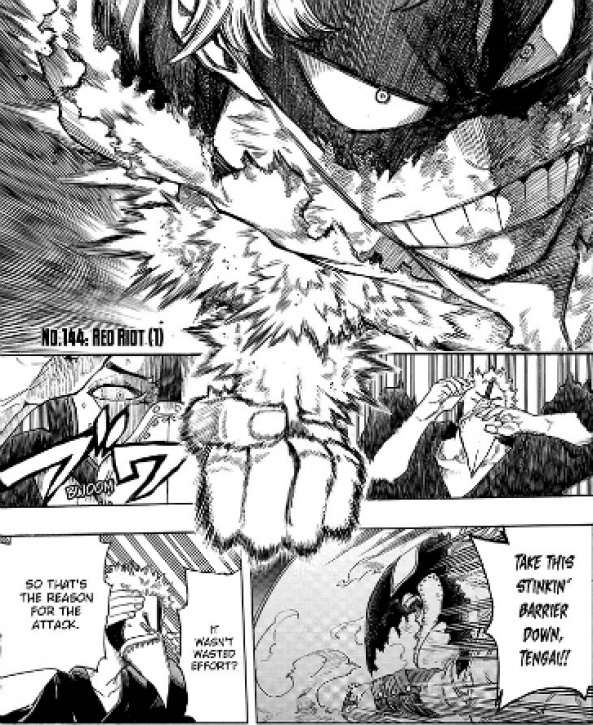
In a large number of battle shōnen series, if a flashback occurs during a fight, it normally happens at a point where the protagonist is on the back foot. Then, following a flashback, they find the inspiration to either fight on until they achieve victory through sheer determination, unlock a new power-up, or remember an important piece of information. In Red Riot’s case though, his flashback (explaining his insecurities, his admiration for Crimson Riot, and his obsession with chivalry and being a hero who protects others) clarifies his earlier actions as he threw himself in front of a barrage of blows from Rappa; in order to try and protect Fat Gum from harm.
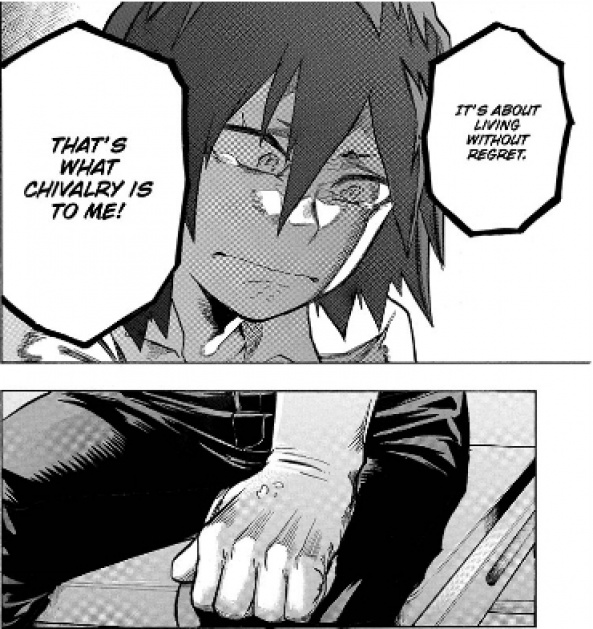
This wasn’t part of some master plan though for the heroes: it was simply the result of Red Riot being afraid of reverting to his old self. He had previously frozen in the face of potential danger and therefore failed to protect his middle school classmates. It is only by chance Red Riot provided Fat Gum with the opening he needed to unleash a fully charged punch, which in turn brought an end to the threat posed by Rappa and Tengai. This kind of approach to a flashback is a welcome change, and thus something Horikoshi should be praised for. It adds a layer of realism to the character’s personality within the established world of the series, rather than stimulating disbelief in the series’ readers.
Continued below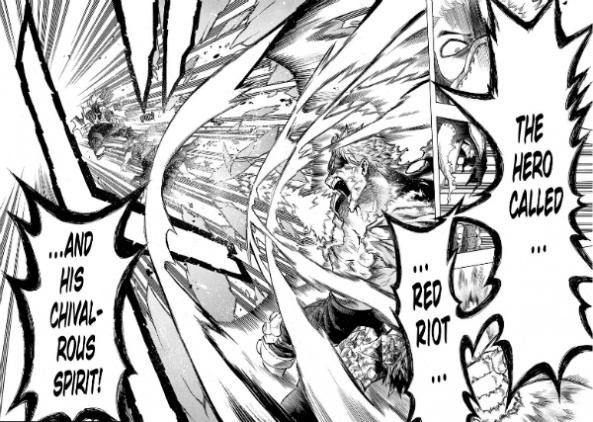
This emphasis on other heroes besides Deku, however, is not all Horikoshi is willing to explore and flesh out for his readers. In addition to these heroic glimpses, we get to see further development for a number of villains in this arc, namely Setsuno, Hojo, Tabe, and Rappa, of the Shie Hassaikai, in addition to the League of Villains as an entity. This insight in particular, of the chemistry between the League’s members following the death of their comrade Magne (at the hands of “Overhaul”, who they are now being strong-armed into working under), is fascinating to behold. Furthermore the development given to Tomura Shigaraki, the League’s current leader and figurehead, is phenomenal.
Throughout the course of the series, Shigaraki has changed drastically. He has experienced both gradual development, through defeat at the hands of the heroes, as well as a particularly extreme and immediate change following the clash between All Might and All For One at Kamino Ward. Prior to Kamino, Shigaraki was heavily reliant on his master for both support and guidance. His child-like disposition tended to define his actions when left to make his own decisions. This resulted in tantrums when things did not go his way and he treated his early allies as disposable (e.g. the Noumu, Muscular and Moonfish). Following the defeat and subsequent arrest of All For One, however, Shigaraki is forced into maturing swiftly . . . if he wishes for the League of Villains to survive.
This shift in mentality — specifically regarding his opinion on the well-being of his villainous allies — is seen initially during Shigaraki’s first encounter with Overhaul. Magne is killed and Mr. Compress loses an arm. His anger at these events, and his willingness to kill an enemy instantaneously as a form of payback, is proof enough Shigaraki no longer treats the League’s members as meaninglessly disposable. This reformed attitude has been expanded upon further though, in the most recent installment of the series, Chapter 148 (‘The Anguish of Young Twoga’). While it had been made clear, prior to the current arc, Shigaraki now cared about the physical well-being of his loyal followers, Horikoshi has now gone further to show Shigaraki’s evolution as a leader. For example, it has been revealed Shigaraki entrusted both Toga and Twice to Overhaul as a sign of goodwill and a means to seemingly build trust between the two newly united groups. This seemingly puts his disdain for Overhaul to the side . . . temporarily.
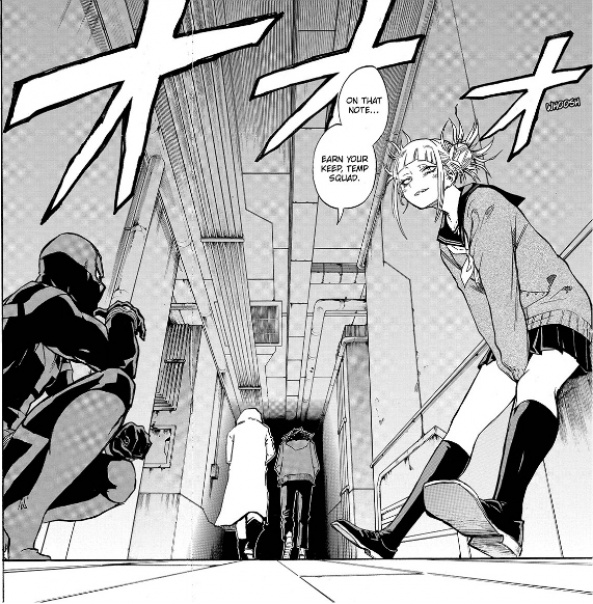
Yet these decisions did not sit well with Twice, who felt responsible for introducing Overhaul to Shigaraki, as it led to the death of Magne. It has been established prior Twice is suffering from mental difficulties, as a result of his ‘Double’ quirk, and so in order to maintain his sanity he keeps his face hidden whenever possible. With this in mind, when he confronts Shigaraki over the decision to send him (an individual with a reason to hate the Shie Hassaikai more than most) and Toga to work alongside their new allies, his disbelief is accentuated by his own decision to remove his mask as he pleads with Shigaraki to reconsider. While the Shigaraki of old may have grown angry at the emergence of any verbal resistance from his underlings, the newly improved Shigaraki takes a different tack.
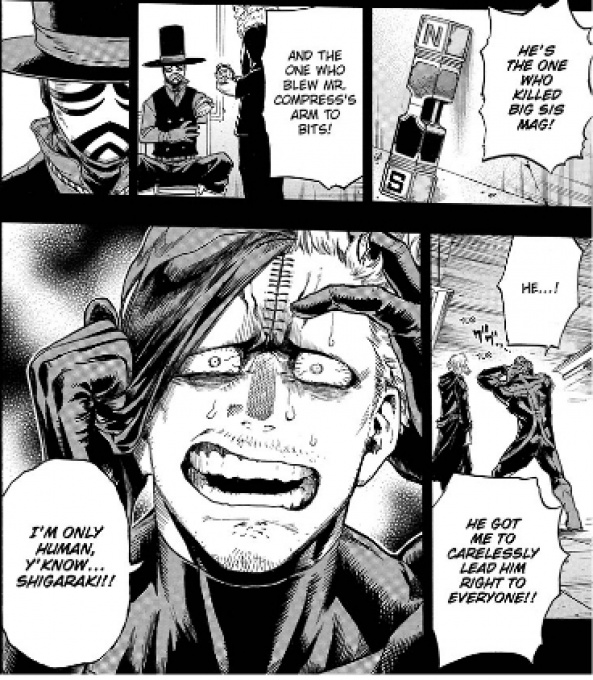
The League’s leader responds clearly and concisely to the grievances of his subordinate, in addition to also removing the item that covers his own face: the hand he calls ‘Father.’ This action visibly astonishes Toga, herself somewhat mentally unhinged, and cements Shigaraki’s shocking actions. He explains the decisions he is making are both for his good, and by extension, their own collective good, as a designated villain organisation. This conversational tactic implemented by Shigaraki (in that he reduced himself to the level of his underling by also removing a precious item momentarily from his person before addressing them whilst holding their gaze intently) is far removed from the behaviour he adopted in prior situations.

This interaction indicates that Shigaraki is also cognisant of the mental state of his immediate allies, as opposed to caring solely about their physical well-being. This new approach to camaraderie for Shigaraki vastly contrasts with the corresponding attitude of the primary antagonist of the current arc, and Shigaraki’s own approach prior to All For One’s defeat at Kamino. This highlights the scope of Shigaraki’s development even further, and truly drives home just how well Horikoshi is handling the prospective ‘Big Bad’ of the series.
Continued belowTo conclude my thoughts for this month: the recent celebration of the series’ 3rd anniversary really highlights the importance of the foundation Horikoshi established for “My Hero Academia.” The well-written story, coupled with the creation of a vibrant world filled to the brim with an eclectic mix of engaging characters, has allowed the mangaka to explore an impressive variety of plot possibilities and character complexity. This narrative formula, combined with clear preparation and masterful execution, ensures an exciting result. I’m certain it will continue to occur for the foreseeable future, given Horikoshi’s prowess as a mangaka.
As always though, I look forward to seeing where Horikoshi next takes “My Hero Academia,” and I hope you’ll join me in September for another installment of ‘Go Beyond,’ to find out exactly that.






